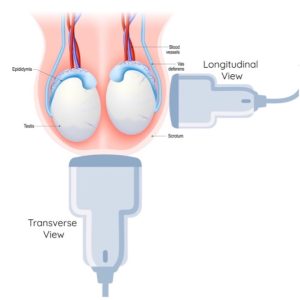Stepwise Technique
1. 2D Grey scale assessment: Start in 2D gray scale mode and scan each testicle in both the transverse and longitudinal planes (Figure 2). This can be used to assess testicle size, lie and texture.
** If using the small linear probe, assess each testicle individually and save images to compare—be careful to not change settings on the machine between sides
2. Dual testicle Comparison: If you have a large linear probe, position the probe in the transverse plane at the inferior scrotum and apply minimal upward pressure to lift both testicles. This allows for direct visualization of both testicles simultaneously to compare size, texture, lie, and doppler flow.
3. Doppler Evaluation: In the longitudinal view, use color doppler to assess flow to the testicles. Start with the unaffected testicle to evaluate the flow on color doppler. Next, assess the affected testicle to determine whether there is increased, decreased or absent flow in comparison to the unaffected side.
** Add pulsed wave Doppler evaluation of both testicles if required by your local policy.

4. Spermatic Cord Evaluation: In the transverse plane, slide the probe superiorly along the length of the spermatic cord. Use greyscale and color Doppler to assess for abnormal twisting. Store a clip of the spermatic cord, regardless of whether it appears normal or abnormal.
5. Documentation: Be sure to document and store images at each step of the exam, including both the affected and unaffected sides.

Figure 2. Ultrasound image acquisition of the testicles in the transverse and longitudinal planes
